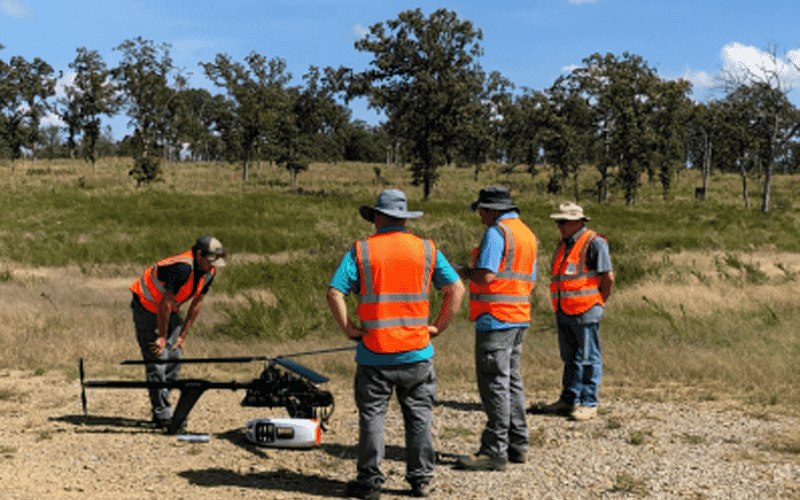Urban Air Mobility Meets [Native] American Ingenuity

Like many Native American people, the Choctaw Nation of Oklahoma (CNO) maintains a long-held respect for the earth and sky. But perhaps unlike some other tribes, the CNO also has a strong understanding of American-style capitalism, especially as a means to communal economic prosperity.
Following in the tradition of the Wright Brothers, several years ago, the CNO leveraged its resources and connections with, for example, the U.S. Department of Defense, to explore the economic benefits urban air mobility (UAM) could offer them in the short- and long-term.
Several years ago, the tribe bought a 25-mile long, 44,000-acre parcel of land. Looking for possible uses, the tribe considered urban air mobility. 
It occurred to Grimsley and others in the tribe that the land could prove valuable to those developing urban air mobility systems. The CNO could act as a catalyst for manufacturing spaces to scale the newly emerging UAM ecosystem by providing test ranges and restricted airspace outside of military zones. The opportunity might also provide job and investment opportunities for tribe members.
UAM: Take Off and Land Here
“We have the resources to control ground risks and to buy radar and air risk management systems,” Grimsley explains. The FAA was conducting its UAM integration pilot program (IPP) so the CNO applied, making them first among Native American tribes to leverage these opportunities.
As a sovereign nation, the CNO was adept at community engagement and helped their community understand the positive effects such an initiative could offer. They set out to build a 35-acre test range with hangars, buildings, towers, and ground-based radar systems. A partnership with Bell Helicopters, which was developing its NEXUS aircraft, helps guide their efforts.
They soon learned that concepts from the 1950s and 1960s, such as multirotor aircraft and hybrid-powered aircraft, which were too complex then, were now viable. Further, it seemed that the Covid-19 pandemic wasn’t slowing UAM development, it was accelerating it.
Drone deliveries, for example, might minimize the need for human contact, thus slowing the spread of Covid-19. This test site would attract companies, create jobs, and spur investment. It would open up opportunities for the CNO and its neighbors.
“Ubiquitous air mobility,” Grimsley says, seemed possible now.
CNO Time Management
The CNO faced the same challenges other communities around the globe faced in bringing this new mode of transportation to fruition: Noise concerns from the community (even though electric propulsion is quieter than conventional systems) and building the infrastructure necessary for electric-powered travel, for example.
But, where others may see hurdles, the CNO saw a clean slate and an opportunity to equalize living opportunities between rural and urban communities. They could leapfrog the hurdles posed by narrow, two-lane, rural roads. They could bring urban conveniences to rural life.
Whereas U.S. investment often revolves around two- and four-year election cycles, the CNO creates 100-year sustainment plans. They can, and do, view their investments around the long-term change it can bring their community.
When They Go High, We Go Low – Low Altitude, That Is
One of the least understood and underexplored aspects of aviation is low altitude flight, the airspace between ground level and 10,000 feet. How weather affects flight and how drones can be used for low altitude weather observation is an area the CNO, in collaboration with academic partners like Oklahoma State University, hopes to shed light on with their airfield.
Using drones, vertical profiles can be developed in this space, creating a rich, 3-D understanding that will inform weather models and increase their accuracy. With better predictions, people will gain confidence when weather warnings are issued. Sometimes, Grimsley explains, if there are too many warnings, people have a tendency to ignore some of them, putting themselves at risk of harm.
As drones are more sensitive to low altitude operations, they can be used not just for delivery but as weather sensors. Still, they may not find a place in daily operations before manned vehicles do. Piloted vehicles are likely to evolve first as they currently have a more clearly defined regulatory path for approval.
All this while another aspect of UAM technologies is evolving more quickly than before: materials used in construction of aircraft. A design cycle that used to take 10 years can now be completed in as little as 18 months. Large, unibody plastics are mature now.
Only one factor of UAM truly remains up in the air, Grimsley says: “Public acceptance.”
Want to continue to stay up-to-date about the latest developments in the eVTOL industry? Subscribe to AeroCar Journal now. It’s FREE (for a limited time)! Join us on Twitter for the latest news, analysis, and insight about the eVTOL industry. AeroCarJ


